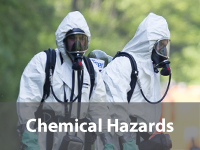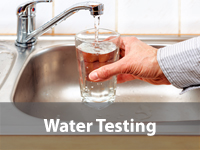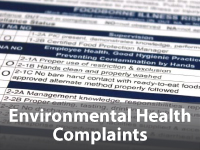Childhood Lead Poisoning Prevention Program

Protecting Your Children From Danger
Lead is a metal commonly found in the environment in soil and industrial paints. Lead exposure occurs in the home environment due to deteriorating paint, which is peeling, chipping, or chalking. There is no known safe level of lead in human blood. Children who are less than 6 years of age are more vulnerable to negative impacts of lead exposure as their nervous systems are rapidly developing and when they start to display increasing hand-to-mouth behavior. Deteriorating paint chips can be ingested by small children and create a dust which many children also come into contact with lead by hand-to-mouth exposure and inhalation. Childhood lead poisoning is 100% preventable. According to the Centers for Disease Control and Prevention (CDC), over half a million children aged 1 to 5 years of age in the United States have blood lead levels which put them at risk for neurological damage and associated behavioral damages with increased exposure.
The goal of the Childhood Lead Poisoning Prevention Program is to reduce and prevent children’s exposure to environmental and occupational lead hazards. A blood test is the only way to determine if your child has a high blood lead level – most children will not show symptoms or signs of exposure. Regional or District Lead and Healthy Homes Coordinators conduct lead-based paint inspections and risk assessments in the homes of children who are under 6 years of age, with a venous confirmed blood lead level of 3.5 micrograms per deciliter or higher. Families should ask their child’s doctor about testing their child and contact their local health department if they are concerned about their children’s lead exposure.
Effects of Childhood Lead Poisoning
Lead poisoning affects children by damaging the brain, a part of the nervous system and some effects may never go away. Continued exposure to lead can cause more severe symptoms. Damage to the child’s health can include:
- Hearing and speech problems
- Behavioral and learning disabilities
- Slowed growth and development
All these symptoms of childhood lead poisoning may lead to a lower IQ, a lower ability to pay attention and underperformance in school.
How Children can be Exposed to Lead
Children can be exposed to lead via a variety of sources and different pathways throughout their environment. Common sources of lead include:
- Lead-based paint – The most common and most dangerous source of lead exposure for children is lead-based paint. Homes built before 1978 usually contain lead-based paint. As the house ages and experiences regular wear and tear, paint has a tendency to chip peel, crack, and as a result creates lead dust, which children can inhale or ingest through hand-to-mouth contact.
- Water – Lead soldered pipes may leach lead into the water supply. If homeowners know their home has older pipes, and feel they could be at risk, it is very important that families utilize cold water for cooking. Utilizing hot water may cause lead to be dissolved in the water more quickly.
- Toys/Jewelry/Furniture – Some toys, jewelry and painted or glazed furniture contain lead.
- Jobs/Hobbies/Cultural Remedies – Some jobs and pastimes and use of cultural cosmetics can involve lead products. Parents may accidentally expose children to lead if they are not properly cleaning themselves before entering the home.
- Soil – Children can be poisoned if they play in lead–contaminated soil from lead-based paint outside of the building or from industry or eating crops grown in contaminated soil.
Lead Testing
Health Care Providers should note that CDC updated the Blood Lead Reference Value (BLRV) to 3.5 micrograms per deciliter. Testing is mandatory for all Medicaid children. Access DPH’s Lead Screening Requirements for Children Ages 6 to 72 Months for detailed information on screening guidelines.
Prevent Lead Poisoning
Childhood lead poisoning is 100% preventable. You can take control of the child’s environment and reduce lead hazards before they are harmed. Lead has no smell and is invisible to the naked eye, but it can be detected with the right tools. Keep in mind these tips to protect your family from lead:
- Have your child’s blood level tested.
- Do not try to sand, scrape strip lead-based paint by yourself.
- Contact your local health department or Regional or District Lead Coordinator about safe home renovations.
- Keep children away from peeling paint, surfaces with lead-based paint or other sources of lead around the home.
- Feed your child foods high in calcium, vitamin C and iron.
- Keep children and pregnant women away from older homes undergoing renovation.
- Wash children’s hands and toys regularly.
- Wet wipe windowsills and floors once a week and maintain housekeeping to keep down lead-based paint dust.
- Shower and change clothes after working with lead-based products. Separate child’s laundry from house laundry
- Use cold water from the tap for cooking or drinking – hot water may contain higher levels of lead.
- Remove recalled toys and jewelry from children. Recalled products can be found on the Consumer Product Safety Commission’s website.
Treatment for Lead Exposure
You can have your child’s blood tested for high levels of lead at your local health department. A blood test is the only way to determine if your child has a high lead level – most children will not show symptoms. Your child’s healthcare provider can recommend treatment options if your child has high lead levels.
Contact Your Local Environmental Health Office
Contact your local Lead Coordinator at 470-576-6708 or call your local health department for more information.
Learn about our related health services:
Additional Resources:


 Contact Us
Contact Us Locations
Locations Job Openings at North Central Health District
Job Openings at North Central Health District Internships
Internships Board of Health
Board of Health Cost and Insurance
Cost and Insurance Privacy Policy
Privacy Policy Teens & Adults
Teens & Adults For Children
For Children Other Programs
Other Programs County Environmental Health Offices
County Environmental Health Offices Chemical Hazards
Chemical Hazards Tourist Accommodations
Tourist Accommodations Food Service
Food Service Rabies Control
Rabies Control Lead Poisoning Prevention
Lead Poisoning Prevention Body Art
Body Art Land Use
Land Use Swimming Pool Program
Swimming Pool Program Water Testing for Private Wells
Water Testing for Private Wells Environmental Health Complaints
Environmental Health Complaints Georgia Food Recall Alerts
Georgia Food Recall Alerts Personal & Family Preparedness
Personal & Family Preparedness Emergency Preparedness for Functional & Access Needs
Emergency Preparedness for Functional & Access Needs Severe Weather Preparedness
Severe Weather Preparedness Emergency Preparedness Training
Emergency Preparedness Training Medical Reserve Corps
Medical Reserve Corps Regional Healthcare Coalitions
Regional Healthcare Coalitions Strategic National Stockpile/Medical Countermeasures
Strategic National Stockpile/Medical Countermeasures






